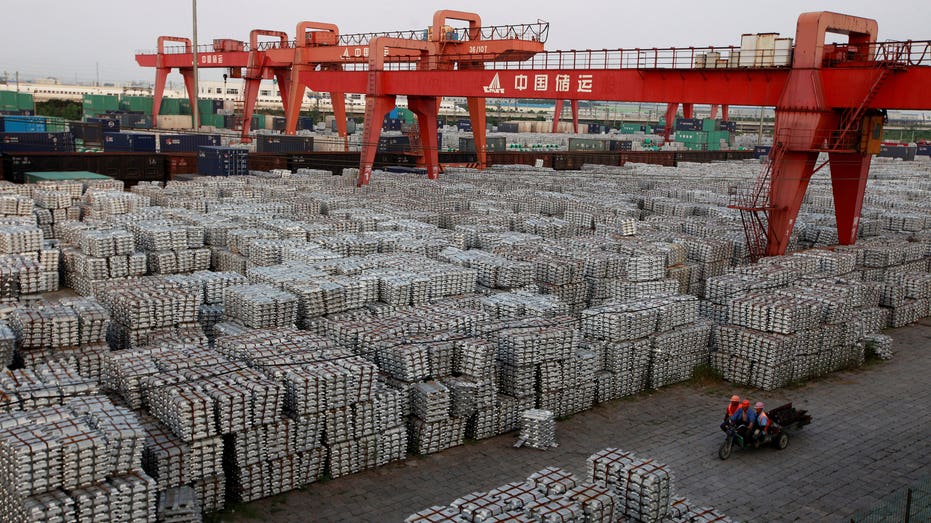Aluminum glut revives financial crisis-era storage trade
At current prices, traders can earn an annualized return of about 2% from stashing aluminum
Wall Street banks and investors are joining commodity traders in stockpiling aluminum, an unconventional way to make money at a time when returns on bonds are historically low.
The pandemic hit the aluminum market hard by triggering a downturn in the auto and aerospace industries, two big buyers of the metal. A surfeit of metal pushed benchmark aluminum prices down 12% this year, to $1,589 a metric ton on the London Metal Exchange.
It also revived interest in hoarding aluminum to sell at a later date, a trade that became controversial after the 2008-2009 financial crisis.
“This is a really telling signal that we’re in a really massive surplus,” said Oliver Nugent, a commodities strategist at Citigroup Inc. “There’s money on the table because the market is paying people to clear markets of this glut.”

Employees work on the production line at the Subaru of Indiana Automotive Inc. (SIA) assembly plant in Lafayette, Indiana, U.S., on Thursday, July 24, 2014. (Ty Wright/Bloomberg via Getty Images)
At current prices, traders can earn an annualized return of about 2% from stashing aluminum in a warehouse, Mr. Nugent calculated. The trade is particularly popular in Europe and Asia, but less widespread in the U.S. because of tariffs on aluminum imports that aren’t from certain countries, he said.
WHO ARE THE BIGGEST HOLDERS OF GOLD?
It works like this: With metal readily available, the price of buying aluminum has fallen below the cost of paying for the material now and taking delivery later. On the LME, the price of spot aluminum was $7 a metric ton below the price of three-month forwards on Friday.
That means traders can buy aluminum on the cheap, typically using borrowed money, and lock in a higher price for selling the metal on the LME through later-dated contracts. If the discount for purchasing aluminum exceeds a trader’s borrowing costs and the expense of keeping the metal in a warehouse, a profit can be made. To maximize their earnings, traders will often truck the aluminum to a different warehouse that charges cheaper rent.
US AUTO INDUSTRY TO BEGIN REOPENING PLANTS IN RECOVERY FROM PANDEMIC
Traders draw parallels with the recent crash in energy markets, when the collapse in demand caused by the pandemic dragged down spot oil prices. Commodity houses including U.K.-listed Glencore PLC and Switzerland-based Vitol Group cashed in by pouring crude into storage and waiting to sell it to buyers at a higher price when demand recovered.

Workers ride on an motor rickshaw through an aluminium ingots depot in Wuxi, Jiangsu province in this September 26, 2012 file picture. REUTERS/Aly Song/File Photo
For financial institutions, the physical aluminum market can be more accessible than oil. The metal isn’t flammable and warehouse space is relatively easy to come by. Aluminum can even be kept outside because it doesn’t rust. Iron fittings on the straps that bind ingots in place—which used to cause problems by corroding in the fresh air—have largely been replaced with plastic.
Sitting on aluminum isn’t the same money-spinner that it was in 2008-2009, when the gap between spot prices and futures was wider than it is now.
In the current market, a company with low funding costs could make around $30 a metric ton each year storing aluminum, according to a U.S.-based metals trader. That equates to an annual profit of $3 million for storing 100,000 tons of metal.
US FRACKERS TO ZERO IN ON RICHEST OIL FIELDS AFTER CORONAVIRUS
JPMorgan Chase & Co. and Citigroup are particularly active in the aluminum-storage trade, according to market participants. Both banks declined to comment.
There’s another incentive for banks to stockpile aluminum. Doing so enables them to hedge large positions they have from selling long-term metal forwards to clients such as auto makers.
Wall Street also got involved in aluminum storage after the last financial crisis. That prompted complaints by beer and soda companies that banks were artificially pushing up prices for end consumers, as the material is used in food-and-drink packaging. A key difference now is that lenders aren’t major owners of metal warehouses, following investigations by U.S. regulators and a grilling of banking executives by the Senate.

Aluminium ingots are seen stored at the foundry shop of the Rusal Krasnoyarsk aluminium smelter in Krasnoyarsk, Siberia, July 27, 2016. REUTERS/Ilya Naymushin//File Photo
But buying aluminum to stockpile comes at a price, and profits aren’t guaranteed.
GET FOX BUSINESS ON THE GO BY CLICKING HERE
Purchasing enough metal to make the play worthwhile is expensive: on top of the LME price, traders pay a premium that varies with the quality of the material and where in the world they buy it. Getting out of the position can be tricky, and warehouse fraud poses a danger for traders who lack a deep understanding of the physical metals market.
“The main risk is that there’s something going on with the metal,” said Edward Meir, a metals analyst for ED&F Man Capital Markets.
Elsewhere in commodities, oil prices fell, putting Brent crude on course for its first weekly decline since late April. The international energy benchmark lost 1.4% to $38.02 a barrel, pushed down by worries that a new wave of coronavirus infections would hit oil demand.




















